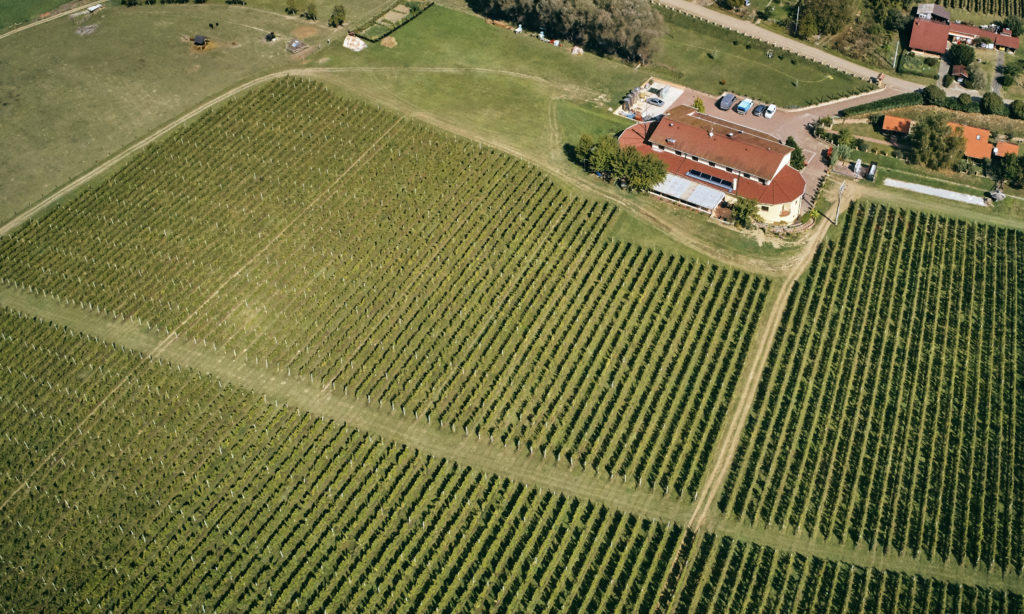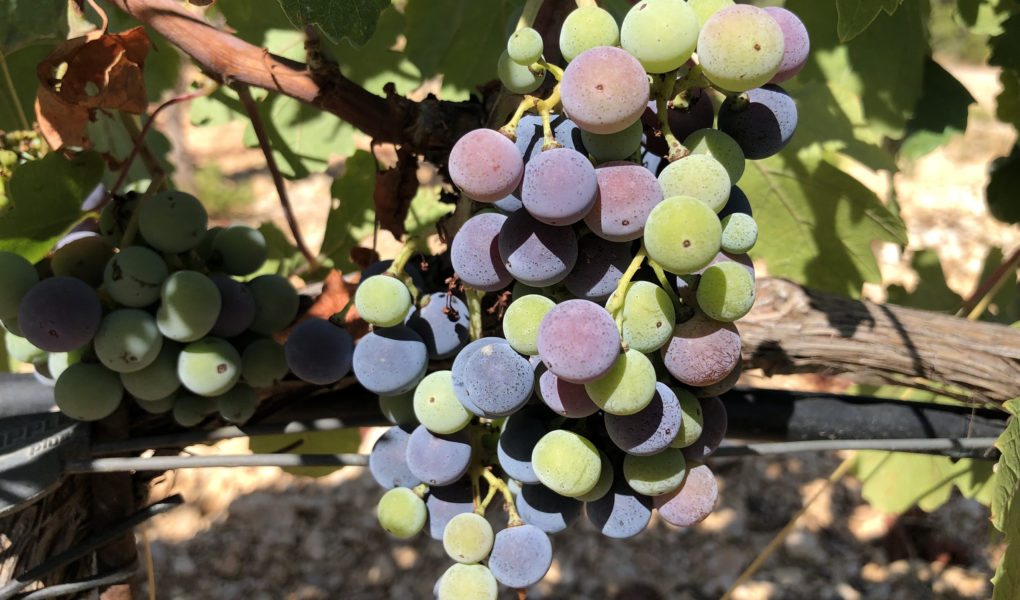This is the eighth in a series of 12 monthly articles following eight Croatian wineries through their year. Catch up on last month’s activities here.
August seems like an easy month in the vineyard. The vines are in full leaf. Abundant bunches of formerly hard, green grapes are starting to turn red or golden and juicy. Vineyards look glorious, striping the hillsides. But winemakers still have work to do to encourage the vines to produce the best quality fruit. They’re preparing the vineyards and winery for the rush of harvest. And they need to gauge the right time to pick. In each region it looks like harvest will be 7 to 15 days later than last year, which makes for cooler grapes and more comfortable workers.
Benvenuti
“Yesterday I visited all the vineyards of Teran and there is no coloring,” reported Nikola Benvenuti on August 3. “Normally at the first of August we see berries starting to be red,” he says. About a week after that happens, they will start a green harvest.
Green harvest involves removing some of the grape clusters just when they start to turn color—when they are still immature, or green. Winegrowers do this for the same reason they did shoot thinning back in May: They need to rein in the natural abundance of the plant, so it produces less fruit of higher quality.
The timing of green harvest is important. “If it’s too early the vine has too much energy to spend,” says Benvenuti. They have to wait until the vine has directed its energy to ripening the grapes. If they green harvest too early, the vine will simply devote its extra energy to producing leaves. Then the leaves will have to be removed later. “Losing energy and time!” says Benvenuti, summing up.
Benvenuti sometimes does green harvest for Malvazija as well, but it usually isn’t necessary. Malvazija produces less fruit than Teran, and thinning the shoots in the spring keeps productivity in check.

Looking ahead, the Malvazija will be harvested around September 7 to 10, and Teran in October. The last vineyard treatment was done a week ago, and now there will be no more, to ensure clean fruit at harvest. Benvenuti hopes the remaining month will be sunny, as there is enough moisture in the soil for the vines’ deep roots.
The danger of rain before harvest isn’t a myth, but it isn’t always a disaster either. As Benvenuti explains, “If it’s right before [harvest], you have to check all the parameters—acidity, sugar, pH—because sometimes the rain can make a disbalance. If I want to pick my grapes Friday and I have the rain Wednesday, I wait till Friday to see, and maybe I’ll wait another two or three days so the sugar and acidity go to the right level.” The bigger problem with rain before harvest is when the season has been too dry. “[In that case] the vines absorb a lot of water,” says Benvenuti, and it can be more difficult to achieve the ideal balance in the fruit.
Vina Kos
The situation at Kos, in the Uplands near Zagreb, perfectly illustrates the give and take between people and nature when it comes to winegrowing. “Usually we remove extra grapes for good quality,” says Karlo Kos, “but this year we didn’t do that because we had frost in the spring and . . . we already lost some fruit. Now we have fewer grapes but it’s good for quality.” The bad frost in April ultimately saved the family the trouble of green harvesting, which they would normally do for Kerner and select Pinot Noir vineyards.
Sometimes, though, a weather event late in the season pushes the growers’ luck a step too far. “Last week in Zelena we had hail, and a lot of vineyards are destroyed,” says Kos. “Maybe 50% or 60% of yield was destroyed by the hail. We are lucky because we have vineyards on five hills and we only had hail in one—of Kraljevina.” Kos is not always happy to have vineyards in five places, which can cause headaches with transport of people and machinery from one vineyard to another. “But when you get hail like last week,” he says, “we are pretty lucky because the hail only damaged a smaller area.”

There will be no green harvest, but at the end of August Kos will still remove leaves from the shady side of each vine row, for better ripening. It will also help during picking. “When we remove the leaves you can see the grapes and it’s easier to cut [them],” Kos says.
The first grapes to be picked will be for sparkling wine. Higher acidity and slightly less sugar are the priorities for sparkling wine grapes. At the end of August, once a day they will go into the vineyards and measure pH, acidity and sugar in the fruit. Closer to harvest, they’ll do this twice a day. This way they hope to come as close to accuracy as possible, using an imprecise method of collecting the sample.
Kos explains: “We go in the vineyard and pick maybe 20 to 50 berries from different places in the vineyard, and also from one side [of the bunch], the other side, on top, on the end . . .” They squash these berries together to get an average of ripeness in the juice they will analyze. The device for this is a refractometer—a portable one for use in the vineyards and a bigger, more precise one in the winery. Still, the berry sampling process has human variation built in, Kos points out. “You see the correct level of [ripeness] when you have the grapes in the press.”
Galić
The first wave of harvest at Galić, too, will be Chardonnay and Pinot Noir for sparkling wine, in Brodski Stupnik, 30 kilometers south of Kutjevo. Starting with this harvest, the Brodski Stupnik cellars will be dedicated to sparkling wine production only.
Wine maker Slaven Jeličić won’t green harvest this year because he is leery of hail. “If you do green harvest and then you have hail, then you have double green harvest and the problem is that you don’t have grapes at all. We are always on the edge, what to do,” he says. Right now their yield is “pretty much optimal”—around 1.5 kilos of fruit per vine. “If we don’t have much more than 2 kilos we don’t touch it. One year we did, and then we had hail and we were left with half a kilo.”

Photo: courtesy Galić
The process of sampling grapes across the vineyard to check for ripeness is universal. But what Jeličić, or any wine maker, is looking for varies according to the wine he will make with the grapes. “The big difference is that for sparkling wines you want to get an elegant, almost silky texture of your future wine. So sparkling wine should be more neutral, very delicate, very gentle, and then in combination with a nice bubble . . . you get a perfect product,” says Jeličić.
“For the normal wine it’s completely opposite. You want to take as much as possible from the skin, the must—complexity, texture, body, aroma, everything.” This full-on flavor would be less than ideal for a sparkler. “A lot of bubbles and a lot of aroma are not good together,” he says.
Jeličić stresses that sparkling wine isn’t made on the basis of ripeness alone. “You cannot produce sparkling wine just by [date] of harvest. You need to pick the best position to get ripe grapes but with a lot of acidity. I try to find vineyards that are lower, closer to forest, to some water,” he says. These vineyard positions would be less desirable for a still Pinot or Chardonnay, but in the vineyard as on the dining table, sparkling wine offers relief from the everyday. “Everything that is opposite of quality is actually good for [sparkling wine],” says Jeličić.
[Title photo: Babić grapes in northern Dalmatia have started to color by the first week of August. In the cooler Croatian regions, grapes are still green. Staff/CCM]

